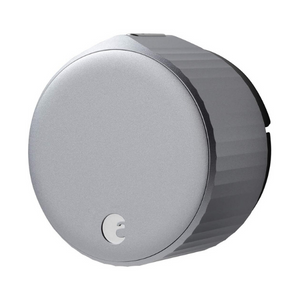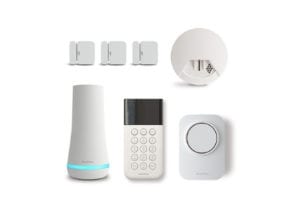Burglars may try a number of methods to try and gain access to your home, including picking your lock. The most obvious signs your lock has been tampered with are visible dents and scuff marks around the key hole. While these are quick and easy to notice, here are specific signs of lock tampering that you can look for and measures you can take to help prevent unauthorized entry.
How to Tell If Your Locks Have Been Tampered With
SafeWise experts have years of firsthand experience testing the products we recommend. Learn how we test and review.
Sign up for our free weekly newsletter to get the best safety news, product info, and deals.
By signing up, you agree to our Terms and Conditions and Privacy Policy.
Have your locks been tampered with? Here's how to tell
Types of unauthorized entry
When you suspect lock tampering—or worse, a break in—the first thing to do is remain calm and assess the situation. What evidence do you have? For example, is anything inexplicably missing, moved, or broken? Any window, lock, or door frame deformed, smashed, or broken? If you have evidence like this, call the police to report it. If not, you might look a little closer for indications of tampering.
Before you go looking for signs of entry, however, it might help to have a basic understanding of the three main ways burglars go about getting through locks.
1. Brute force
This is the hastiest, and therefore messiest, form of attempted break in. Often a criminal will try to bash in a lock, drill through a deadbolt, or kick down a door, leaving a trail of twisted metal and splintered wood. There are less obvious ways to force through a lock though, so you might also look for some of the following signs of unnatural wear.
Signs of brute force
- Paint circles from lock fixture movement (like it was loosened and retightened out of place)
- Bent deadbolts or latches
- Warped doors/doorframes
If you notice that your key is suddenly harder to turn than usual, this could indicate pin deformation—a result of more refined methods of lock manipulation like bumping or picking.
2. Bumping
Since the early 1900s, locksmiths have used a secretive technique called "bumping" to open locks in a hurry. In 2005, a Dutch talk show revealed the process and, since then, the technique has been picked up by countless burglars worldwide.
To do this, burglars file down the teeth of a key into several points, sort of like a little saw. Next, they insert this “bump key” all the way into a compatible keyhole and withdraw it one click. Then they strike it abruptly with a blunt object, withdraw one click again, and repeat until the lock tumblers have all caught. Finally, they turn the key and open the door.
When done correctly, this method leaves little trace. Sometimes, however, hasty amateurs can leave identifiable marks.
Signs of bumping
- Fresh nicks around the edges of the keyhole from pounding the key a little too forcefully
- Shiny metal edges that look like they’ve been recently hit
3. Picking
The third and most traditional method of tampering with locks is "picking." This is where a person uses small tools like a flat screwdriver to turn the lock and a pick (sometimes even a dental pick) to rake the pin tumblers. Like bumping, once the tumblers catch the lock easily turns.
This takes more time and expertise than bumping, but is gentler and therefore unlikely to leave indications like warped pins or bolts. Nevertheless, as picks and shims (i.e., screwdrivers) wiggle around inside, they can cut into the edges, leaving marks.
Signs of picking
- Tiny scratch marks, showing fresh, shiny metal around the key hole (finer than from a key)
Prevention strategies
Now that you know what signs to look for and how they happened, you can consider options for rectifying the problem. One of the best ways to deal with lock tampering is to change your locks to deadbolts, or upgrade them to hybrid digital/mechanical bolts, which are not as dependent upon tumblers and pins.
As a bonus, electric locks help prevent you from getting locked out of your own home since they often have keypads or sync with a smartphone app.
You can also use a device which prevents turning of a deadbolt even after it is unlocked. And in brute force situations, having a sturdy door, like one of our top security door picks, is ideal.
It might be time to consider installing a DIY home security system. That way even after you’ve changed locks and reinforced doors, if a criminal tries to force their way back in they’ll set off alarms or get caught on tape, offering you and your family yet another layer of protection.
Info current as of post date. Offers and availability may vary by location and are subject to change.
If you’re interested in this kind of monitoring, compare home security packages so you can find a security company that meets your needs.
Compare the best home security systems
Info current as of post date. Offers and availability may vary by location and are subject to change. Read full disclaimer.
Full ADT disclaimer
Data as of post date. Offers and availability may vary by location and are subject change.
Full ADT disclaimer
FAQ
Get to a safe place and call 911. Check out our burglary tips for more information.
A deadbolt is considered the safest type of lock. These are our top picks for the best door locks.
There is a burglary every 30 seconds in the United States.
For more safety tips specific to your area you can contact your local police department or crime prevention council.
Related articles on SafeWise
Disclaimer
Product prices and availability are accurate as of the date/time indicated and are subject to change. Any price and availability information displayed on Amazon at the time of purchase will apply to the purchase of this product. Safewise.com utilizes paid Amazon links.
Certain content that appears on this site comes from Amazon. This content is provided “as is” and is subject to change or removal at any time.
Recent Articles






